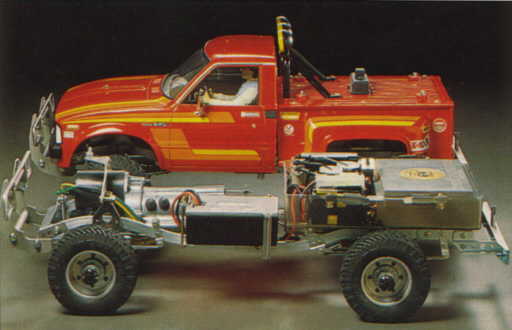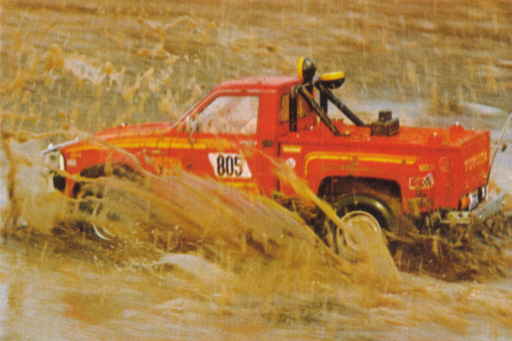|
|
english
version 
|
|
Tamiya
TOYOTA HILUX 4X4
The
Ancestor
|
|
|
|
!!
Please note, that loading times may be increased due to the
picture sizes !!
!!
Picture sizes shown, when "hovering" !!
|
| |
 |
|
Tamiya
had settled for a new milestone in 1982, after several other
"firsts" of this enterprising model company from Shizuoka,
Japan. The Toyota Hilux 4x4 was introduced, a model so incom-parable
in many points of view. Did most model companies hide the adapted
techniques under the bodies, on the chassis of this vehicle
it was worth to take a closer look. |
| |
|
Left
picture: The Tamiya Hilux with and without body, from the
1982 Tamiya catalogue.
For
an enlarged view, please click on the picture.
|
|
This
model had a classic ladder-frame with rails made from massive
aluminium, joined together by cross members made from aluminium
and steel sheetmetal. The die-casted rigid axles have been
mounted to the frame by using leafsprings. The Hilux was driven
by a Mabuchi 540 motor, distributing its power to the axles
via a 3-speed-transmission, that even had a die-casted housing.
In the low first gear the Hilux was running in four wheel
drive, in the middle second and high third gear only the rear
axle was driven. The hubs on the front axle could be locked
manually, like it could be found on many contemporary fullsize
off-road-cars. The tires with their realistic pattern were
mounted on two-piece aluminium rims made from sheetmetal,
the tires theirselves carried two-piece plastic inserts. Not
enough with all that, the motor received its current from
a semi-mechanic transistor speedo, controlled by a servo,
which was mounted in the mechanism box. Also located in this
box were the servos for steering and shifting, that did their
task via servosavers. Furthermore the receiver, its powerpack,
the ON/OFF-switch and the main battery were placed in this
box. All in that the r/c-components had been reasonably protected
against water and dust.
|
|
The
fascinating chassis had been topped by a body that has been
unparalleled until today. No model on the market had a comparable
body. It was inspired by the original Hilux to the last detail.
The grille carried headlamps that could be made working with
ease. The drivers compartment had a realistic interior including
a drivers figure. The rear of the body has been featured as
a stepside-bed, with a rollbar and KC-lights on top. Provided
a good detailed paint job, it was difficult to distinguish
the model from the real truck. All in one this truck was a
real milestone in r/c-history. The Hilux and his successors
had set standards in scale appearance that have never been
reached by models of other companies.
|
|
|
| |
|
Right
picture: The Tamiya Hilux with and without body, from the
1982 Tamiya catalogue.
For
an enlarged view, please click on the picture.
|
|
But
the model even had some disadvantages. The engineers at Tamiya
had to accept some compromises in return for the high details.
The axles didn't bear any differentials, the scale axle cases
weren't large enough to accomodate them. For the most hobby
pilots the chassis wasn't off-road capable enough, it was
often strained by the terrain where it was forced through.
The hard tires, the stiff leafsprings without dampers and
the rigid frame made this truck jump like a rubber ball. Contemporary
modelers transformed the leafsprings into control arms by
cutting the rear edge and mounting coils springs and dampers.
The ground clearance was not very lavish. If running in a
scale-like terrain one didn't had any problems, but most drivers
ran it in a much too rough environment, where the Hilux couldn't
compete with contemporary buggies.
|
|
|
|
The
price that had to be payed for a Hilux, made it a "toy"
for grown-up people. The younger generation was in most cases
unable to afford that truck. And many ambitioned drivers had
the opinion that, they may get a more versatile vehicle for
so high a price. At least one had to consider that he would
have to pay for a radio and batteries too, after purchasing
the model.
|
| |
|
Left
picture: The Hilux from the 1982 Tamiya catalogue.
|
|
Nevertheless
this model is representing a terrific piece of r/c-history.
All the fascinating technical gadget, that have been realized
in this model, made it unique. The whole series up to the
end of production of the Mountaineer in 1995, showed a style
of modelling, that actually wasn't as appreciated as it should
have been. The unnoticed end, provided to this series by Tamiya,
was something that these models have not deserved.
Models
of the Hilux are always high in course, maybe not as high
as the Bruiser. That may depend on the charisma of the Bruiser,
that, even when it was more versatile than the Hilux, not
as performant as it looked like. Good spares for the Hilux
are hard to get these days. There has grown a small community
in the past, that is collecting and preserving these models.
There has been an attempt to induce Tamiya with a petition
to re-release that type of kit. If Tamiya has been touched
by this measure, remains to be seen.
|
| |
| technical
data: |
|
length:
|
500
|
mm
|
|
| width: |
230
|
mm
|
|
| height: |
200
|
mm
|
|
| wheelbase: |
287
|
mm
|
|
| tread
f/r: |
125/145
|
mm
|
|
| tireØ: |
88
|
mm
|
|
| tirewidth: |
35
|
mm
|
|
| weight: |
4.000
|
g
|
|
|
|
|
|
|
Right
picture: Hilux in Action, from the 1982 Tamiya catalogue.
|
|
 |
| |
!!
I would highly recommend to visit Roby's
old Tamiya Database to look for the original Tamiya video
of this truck, it's really marvellous, even when it has some
dropouts! The video has a size of 65 MB !!
|
| |
|
All
pictures are copyright of
Tamiya Co., Japan
|
|
|